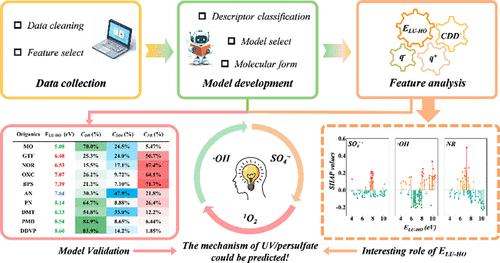Combination of Density Functional Theory and Machine Learning Provides Deeper Insight of the Underlying Mechanism in the Ultraviolet/Persulfate System
IF 10.8
1区 环境科学与生态学
Q1 ENGINEERING, ENVIRONMENTAL
引用次数: 0
Abstract
The competition between radical and nonradical processes in the activated persulfate system is a captivating and challenging topic in advanced oxidation processes. However, traditional research methods have encountered limitations in this area. This study employed DFT combined with machine learning to establish a quantitative structure–activity relationship between contributions of active species and molecular structures of pollutants in the UV persulfate system. By comparing models using different input data sets, it was observed that the protonation and deprotonation processes of organic molecules play a crucial role. Additionally, the condensed Fukui function, as a local descriptor, is found to be less effective compared to the dual descriptor due to its imprecise definition of f0. The sulfate radical exhibits high selectivity toward local electrophilic sites on molecules, while global descriptors determined by their chemical properties provide better predictions for contribution rates of hydroxyl radicals. Interestingly, there exists a piecewise function relating the contribution rates of different active species to ELU–HO, which is further supported by experimental data. Currently, this relationship cannot be explained by classical chemical theory and requires further investigation. Perhaps this is a new perspective brought to us by combining DFT with machine learning.

密度泛函理论与机器学习的结合深入揭示了紫外线/硫酸盐系统的基本机制
活性过硫酸盐体系中自由基和非自由基过程的竞争是高级氧化过程中一个引人入胜和具有挑战性的话题。然而,传统的研究方法在这方面遇到了局限性。本研究采用DFT与机器学习相结合的方法,建立了过硫酸盐紫外体系中活性物质的贡献与污染物分子结构之间的定量构效关系。通过比较使用不同输入数据集的模型,发现有机分子的质子化和去质子化过程起着至关重要的作用。此外,由于对f0的定义不精确,作为局部描述符的精简Fukui函数与对偶描述符相比效果较差。硫酸盐自由基对分子上的局部亲电位点表现出很高的选择性,而由其化学性质决定的全局描述符可以更好地预测羟基自由基的贡献率。有趣的是,不同活性物种对ELU-HO的贡献率存在一个分段函数,实验数据进一步支持了这一函数。目前,这种关系还不能用经典化学理论来解释,需要进一步的研究。也许这是DFT与机器学习相结合给我们带来的一个新的视角。
本文章由计算机程序翻译,如有差异,请以英文原文为准。
求助全文
约1分钟内获得全文
求助全文
来源期刊

环境科学与技术
环境科学-工程:环境
CiteScore
17.50
自引率
9.60%
发文量
12359
审稿时长
2.8 months
期刊介绍:
Environmental Science & Technology (ES&T) is a co-sponsored academic and technical magazine by the Hubei Provincial Environmental Protection Bureau and the Hubei Provincial Academy of Environmental Sciences.
Environmental Science & Technology (ES&T) holds the status of Chinese core journals, scientific papers source journals of China, Chinese Science Citation Database source journals, and Chinese Academic Journal Comprehensive Evaluation Database source journals. This publication focuses on the academic field of environmental protection, featuring articles related to environmental protection and technical advancements.
 求助内容:
求助内容: 应助结果提醒方式:
应助结果提醒方式:


